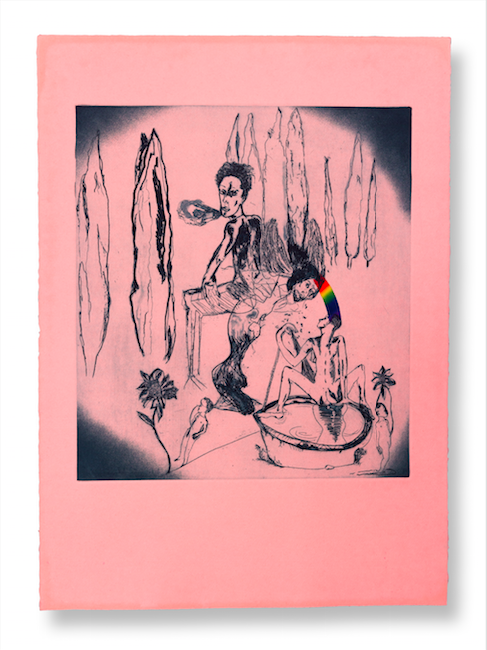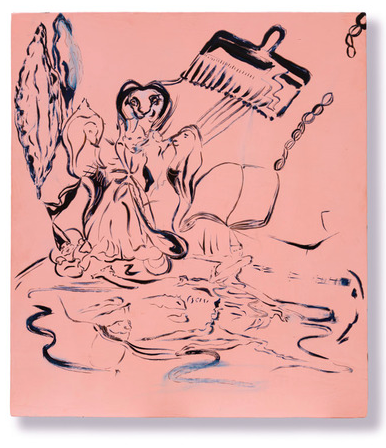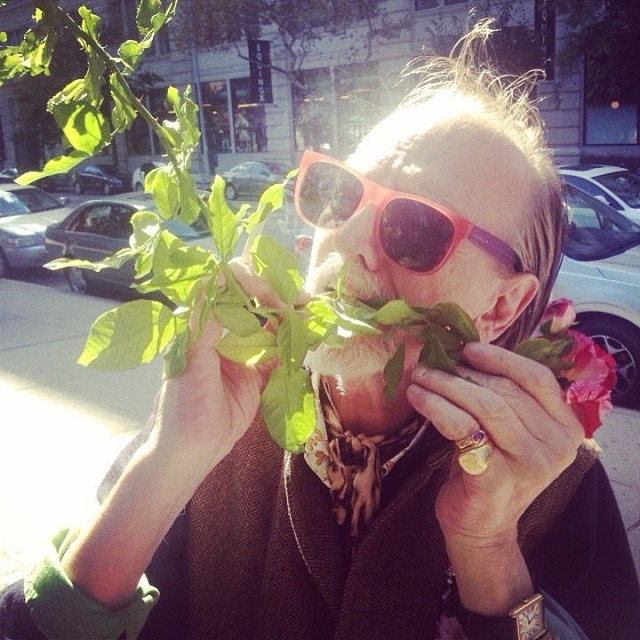As a follow-up to my 2013 interview with Lola Montes Schnabel, I met with the artist at her family home in Bridgehampton to talk about her current exhibition at Tripoli Gallery in East Hampton. The exhibition, Akashic Records is a new body of work made in various locations around the world. It could be said that Montes Schnabel’s work is a fantastical documentation of her life. There are moments filled with truth that could only emerge via the brushstroke or mark-making on surface. For Akashic Records, she has employed sipo, a soft lightly colored wood that she heavily sands and carves into directly. The curvature follows the direction of the artist’s hand and is really just another method of drawing, allowing for another level of texture even if subtle. From the press release:
In theosophy and anthroposophy, the Akashic records (a term coined in the late 1800s from akasha or ākāśa, the Sanskrit word for “sky,” “space,” “luminous,” or “æther”) are a compendium of thoughts, events, and emotions believed by Theosophists to be encoded in a non-physical plane of existence known as the astral plane. There is no scientific evidence for existence of the Akashic records.

Lola Montes Schnabel, “The Rainbow Connection” (2014) Etching, 18 x 16 inches, edition of 30
Courtesy of Tripoli Gallery, Southampton and East Hampton, New York. Photo by Ryan Moore, 2015
Katy Diamond Hamer: The Akashic Records series is a nice evolution from your last body of work. For one thing, they are mostly all on wood and the drawing is present through engraving, interacting directly with the surface in a different but similar way than with a brush.
Lola Montes Schnabel: The lines I’ve used to make this work have a similar quality to when you put your lovers name into the bark of a tree; there is a permanence. I wouldn’t refer to it as carving as I think it’s just a new way to make a line, or make a drawing turn into a painting, then a sculpture. There is something satisfying about digging in and excavating the surface, in a similar way that one might excavate their own skin.
KDH: Can you talk a bit about the figures or the allusion to figures in Akashic Records and where they come from Specifically in “Resting With Demons” (2015)?
LMS: Well, in that particular painting I wanted to capture what it is like to look down at your own body. Often times I think these two legs look like curtains of a stage and then your body just curves in. When I’m driving my car and the breeze is hitting my face I feel like angels are kissing my cheeks like little fairies. I can’t believe that we are in these perishable carriers or that we are taking up this space and it still surprises me that I’m in a body sometimes. I feel like these new paintings respond to the question, that how, on a cellular level we are being hijacked by our ancestors, the people who didn’t finish their work and come through you. We have our grandparents and their parents, and I often think about ‘who are you?’ at what point does the soul enter the body? Is it during conception, the first heartbeat, the first breath? Then I find myself contemplating, when do you become your own person? The whole process of self discovery and letting a child just be who they are [is something I’m interested in]. If you look at someone’s nose, it’s taken so many people to make that nose. So this idea of cutting the Akashic core to face your genealogy to say ‘I don’t want this anymore’.
In a way, they (the figures) are projections on the sky. I love the way they are out there, suspended, and not attached to anything.

Lola Montes Schnabel,
“Message From Rene”, (2015) oil on linen, 86-1/2 x 67 inches, Courtesy of Tripoli Gallery, Southampton and East Hampton, New York. Photo by Ryan Moore
KDH: The ground in this series is a soft, peach or pink color, very warm, almost like the flesh of a newborn baby. When working did you have to wait until the top layer of paint dried completely before interacting with the rest of the surface?
LMS: The grounds do look really soft, almost as if to invite the viewer to reach out and touch them just to see if it would leave an imprint. The sanding process was first. I sanded each piece of sipo and made round corners, so nothing is pointy and then poured the paint on top, whipping and mixing up the color, I applied that and allowed it to dry almost completely before interacting with the surface. The figurative work is really my own mythology. I was thinking about what its like to let someone live off of your life energy. The piece you mentioned “Resting With Demons” is when you don’t realize that someone is literally living off of your life force and it can be very draining, just to be next to someone. No matter how sexy it is, sometimes the most exciting experiences are with people who are quite sick and they pick the opposite because they need that to balance them. That type of energy or relationship can totally throw you off and its possible to feel as if you are present, but not fully in your own body. I like to draw the face in extreme perspective, at an angle that is a challenge. At one point I made a Play Doh nose and put it on a camera lens because I don’t want to just draw the body, I want to be in it. If you close one eye you can see the corner of your nose and a triangle of your cheek.The body is like a Greek vase. The torso is like a panel of meaning, how do you take the torso and make it into a story being told?
I made this sculpture once where I dug out the bark from the inside of a tree and put a bunch of amber jelly in it and then a loaf of bread. Similar to when you are building something with someone, even a romantic relationship, you are trying to preserve something that is holy. Since Rene [Ricard] died I have to say, I was thinking about the astral plane since he took so many drugs and was such a beautiful soul. I had a dream where he told me “It’s so much easier to paint up here, with one brushstroke I can make a rainbow with one arm.”
KDH: That is beautiful. Is that where the presence of the rainbow came from in “The Rainbow Connection” (2014), the only etching in the exhibition?
LMS: I was in a residency in Italy at the Fondazione Il Bisonte and where I was working there was a shape that formed a prism. One morning I went to the studio and on the drawing was a rainbow, exactly between the male figures head stretching to her head as if transferring some information, as if from the penal gland to the other. The etching is an edition and 22 have the rainbow while the others don’t because I didn’t want them all to be the same and rainbows also have a tendency to come and go. To make the rainbow, we used a roller and painted it by hand onto each etching, in one quick gesture.
KDH: Have you ever thought about adding a performative aspect to your work?
LMS: I would love Benjamin Clementine to play at one of my shows and do his portrait while he’s playing…or something like that. I’d love to combine these worlds. I also feel more comfortable now using myself in things whether it is text or otherwise, but I still have to be sure before putting it out into the world. When I was a kid I would put on performances and dress my brother and sister in costume and have music planned and would work on them for weeks and then make everyone sit and watch the show, so this isn’t necessarily a new thing, it’s just finding it’s way back.

Lola Montes Schnabel, “Akashic Records” installation view, Courtesy of Tripoli Gallery, Southampton and East Hampton, New York. Photo by Ryan Moore
KDH: It’s as if the drawings and paintings are emerging from a film screen in your mind, right?
LMS: I usually just start drawing and then the visual emerges. Lately, I’ve been thinking about and responding to physical changes in my body as well. It’s very strange when you enter your 30s and you are aware of this clock ticking since we have over two million years of procreation knocking on our door, even if you are not ready. In your head or heart, your body wants to grab onto something, and I’m watching hormones hijack me in the same way ancestors hijack you. I find myself asking, what is really me and what is it that other people are trying to live through me and my hormones? I work through these things in my drawing practice. The experience often goes into my work and then departs because it’s a surrogate experience. There is a benchmark and you can move on rather than to dissect it in a cerebral way, so it is a kind of therapy too. I cannot look at things that are not emotional.
KDH: There is a psychological aspect but physical as well, because you are really interacting with the surface.
LMS: With these works I really sanded the surface because I wanted them to look like the texture of a refrigerator door. As an artist you really need to protect your imagination and who your head sleeps next too because it effects your dreams. My dreams reflect my paintings so I really can’t have someone with nervous energy, I can’t afford to carry something like that. We all talk about the concept of ‘team’ but there is no team, we come on our own and leave on our own.
KDH: Can you talk about your Instagram name and what that means?
LMS: The name I use for Instagram, Motherfuture is an idea about not being allowed be a mother, if you’re not a mother to everyone. If you are walking on the street and see someone who is going to faint because they have pneumonia, you ask them, how are you? Can I help you? Even if you’re in a rush and see a straw wrapper on the ground, you pick it up, otherwise, we’re just living in a garbage can. There is a maternal quality to the way we interact we the world.
KDH: You made this body of work in St. Bart’s and also in Italy. What was that like?
LMS: The logistics of not having a studio and making the work in other places is a challenge and sometimes I feel like a camel. The wood panels are heavy, dense African mahogany, and I was lucky to have all the work I made in St. Bart’s shipped in a shipping container of a woman who I met while living there.
KDH: Let’s explore more along the lines of the exterior of the painting, specifically regarding these new works with their fleshy ground and engraved surface. I like thinking about the paintings as an amputation, something that is such a part of you but then can be shipped or carried around.
LMS: I’m watching my first wrinkles emerge and am aware that our bodies are something that we carry and that change. I”m happy to be at each stage of life and appreciate watching the changes. I see myself very old with long, long, long hair. I felt so grown up when I was younger and now I’m feeling more like a teenager, innocence and maturity, being ancient and being like a baby at the same time.

Lola Montes Schnabel, “Cutting the Akashic Cords” (2015), pigment, enamel, glue, and oil paint on sipo, 38 x 35 inches, Courtesy of Tripoli Gallery, Southampton and East Hampton, New York. Photo by Ryan Moore
KDH: When making your work, specifically this series, are there any artists who you look towards or find inspiration from?
LMS: Luigi Ontani has a really big influence because he uses his imagination and it’s a total exit out of reality. He’s my favorite living artist. He’s also kind. This is someone who speaks the most beautiful Italian and is probably one of the most intelligent people I’ve ever met, there are so many literary references that he uses [in his work]. He really see’s people and is very generous. Also, he’s not afraid of color and uses them in really the most impossible of ways.
KDH: I know you are close with him, how did you initially meet?
LMS: We met through Rene Ricard at Exit Art when I was just twelve years old at an Iké Udé exhibit. There was a photo-booth there and Luigi had a little chihuahua in his pocket, I loved the dog and he said, “Let’s take a picture together”. I was just amazed by this person. The next day he asked my mother if he could take me to the Egyptian exhibition at the Met. Then at age sixteen or seventeen I’d go to Rome and he introduced me to Piero de Cosimo and the sea monsters he painted and Guido Reni. He doesn’t speak English very well and I don’t speak Italian but we can have conversations and he’s like a guru or a living saint in a way. He calls himself an amateur but he is art and his life is art.
KDH: Do you have an editing process? Do you make a ton of work and then edit down when it comes time to show?
LMS: I made a few that I didn’t think were as good as the others and I just left them behind. Sometimes I cut things up and destroy them, it’s all part of the process.
Lola Montes Schnabel “Akashic Records” closes at Tripoli Gallery in East Hampton on August 23rd, 2015.


